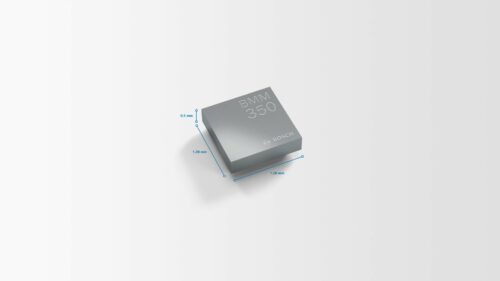The compact and shock-proof magnetometer employs Tunnel Magnetoresistance (TMR) technology, ensuring consistent and accurate results.

In portable devices, while other motion sensors can provide information about your location and velocity, a dependable magnetometer is required to determine the direction you are facing. Like a compass, the magnetometer offers precise measurements of orientation concerning the Earth’s magnetic field. Bosch has launched a 16-bit 3-axis magnetometer, BMM350 to determine the direction while consuming minimal power, thus extending battery life. The company claims that the magnetometer opens up many possibilities, including detecting head orientation for immersive 3D audio experiences and reducing pixel latency in augmented reality/virtual reality (AR/VR) applications to enhance user satisfaction and prevent motion sickness.
According to the press release issued by the company, the sensor is well-suited for indoor navigation scenarios where the Global Positioning System (GPS) is unavailable. With compact dimensions of 1.28mm x 1.28mm x 0.5mm, this device is nearly invisible. It is best suited for wearables, hearables, smartphones, tablets, Augmented Reality (AR) and Virtual Reality (VR) devices, and various types of vehicles. The magnetometer uses innovative tunnel magnetoresistance (TMR ) technology and includes a unique field shock recovery feature. This capability enhances the device’s resilience against external magnetic fields, ensuring consistent high accuracy in all circumstances. The new device offers significantly improved performance compared to the previous generation magnetometer.
The company claims the sensor exhibits a substantially reduced power consumption, with an average, typical current consumption of only 200 μA at a 100 Hz data rate 20 times lower than its predecessor. The MEMS sensors stabilise images, detect gestures and activities, and count steps when incorporated into smartphones and tablets. The built-in MEMS sensors allow users to operate smart devices through gestures or voice input. The sensor has high sensitivity and resolution, allowing it to detect subtle changes in the magnetic field.
Some of the technical specifications of the magnetometer include:
- Package dimensions: 1.28 x 1.28 x 0.5 mm³ wafer level chip scale package (WLCSP)
- Operating range: -40 °C to 85 °C
- Supply voltage: VDDIO: 1.72 V to 3.6 V / VDD: 1.72 V to 1.98 V
- Sensitivity Temperature Drift: ± -0.010 %/K
- Average typical current consumption: 200 µA @ 100 Hz in normal mode
- Magnetic field range, all axes: ± 2000 µT







Package dimensions:
(1.28mm x 1.28mm x 0.5mm)
or
(1.28 x 1.28 x 0.5) mm³
or
footprint 1.28 x 1.28 mm², height 0.5mm
Sensitivity Temperature Drift (typ.)
± 0.010 %/K
Interface: I²C and I3C